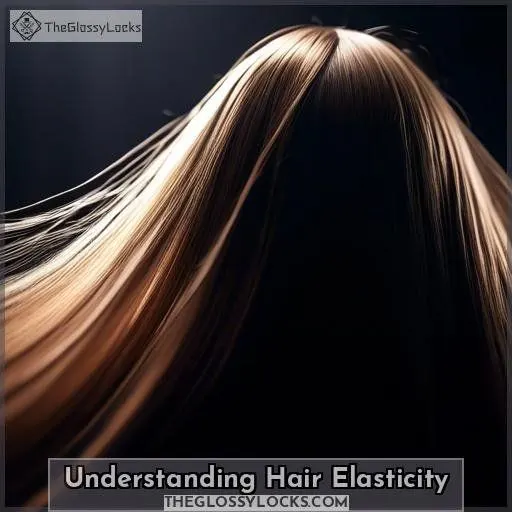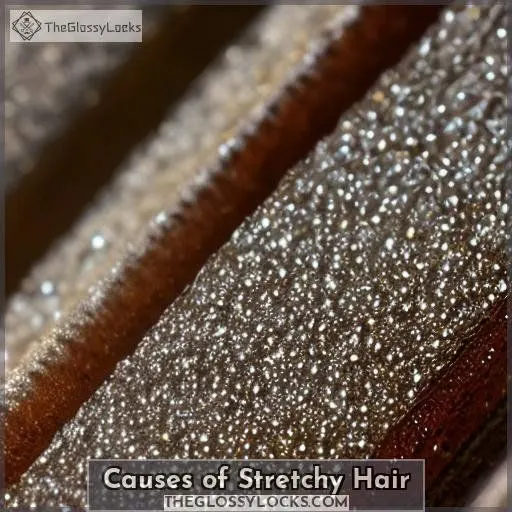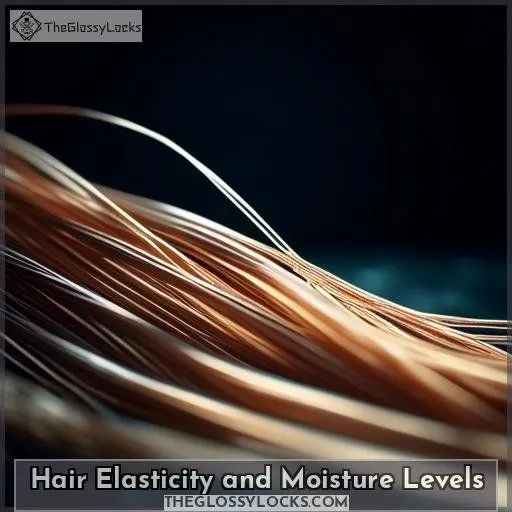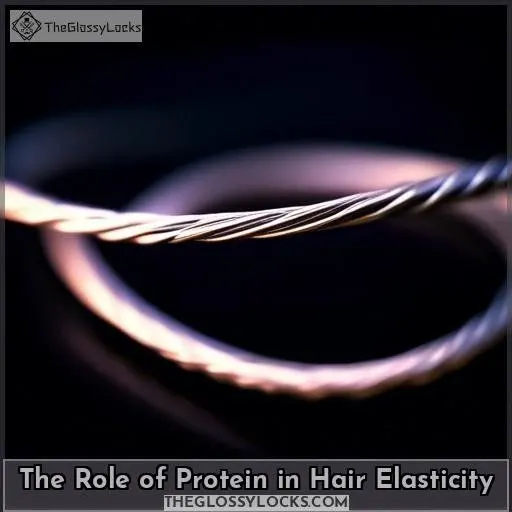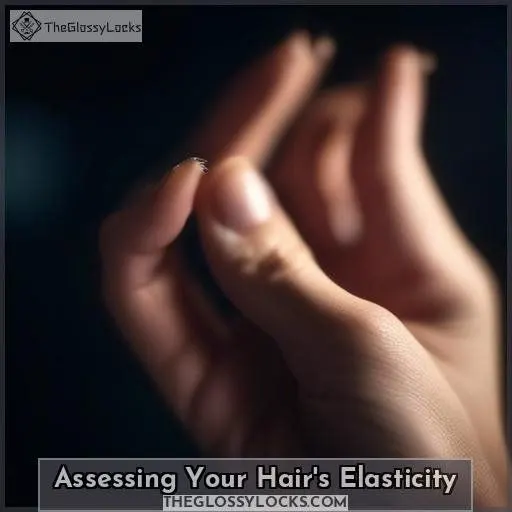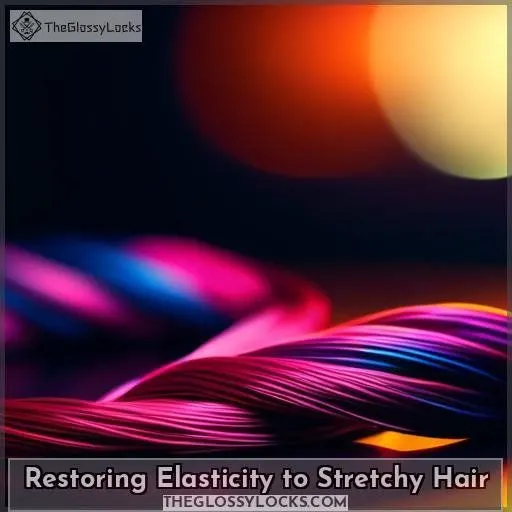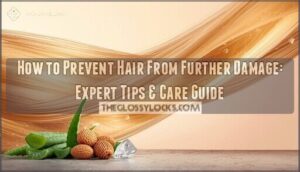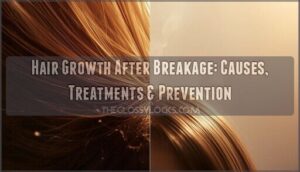This site is supported by our readers. We may earn a commission, at no cost to you, if you purchase through links.
If your hair feels overly stretchy, it’s likely a sign that the delicate protein-moisture balance within your strands has been disrupted, leading to damage and weakening. Excessive hair stretch can be caused by heat styling, chemical treatments, and environmental factors that compromise the integrity of your hair.
When your hair becomes too elastic, it becomes prone to breakage and lacks the manageability you desire. Addressing the root causes of your stretchy hair, whether it’s over-moisturization or protein deficiency, is key to restoring healthy elasticity and strength.
Continue reading to learn more about the factors influencing your hair’s elasticity and the steps you can take to revitalize it.
Table Of Contents
- Key Takeaways
- Why is My Hair Stretchy?
- Understanding Hair Elasticity
- Causes of Stretchy Hair
- Hair Elasticity and Moisture Levels
- The Role of Protein in Hair Elasticity
- Assessing Your Hair’s Elasticity
- Restoring Elasticity to Stretchy Hair
- Preventing Future Elasticity Issues
- Frequently Asked Questions (FAQs)
- Conclusion
Key Takeaways
- Excessive stretchiness in hair is a sign of disrupted protein-moisture balance, leading to damage and weakening.
- Heat styling, chemical treatments, and environmental factors can contribute to stretchy hair.
- Maintaining a balance of moisture, protein, and elasticity is essential for healthy hair.
- Addressing the root causes of stretchy hair, whether it’s over-moisturization or protein deficiency, is crucial for restoring healthy elasticity and strength.
Why is My Hair Stretchy?
Your hair is stretchy because it may have too much moisture and not enough protein, indicating a need for a better moisture-protein balance. To fix stretchy hair, consider using repairing products and adjusting your hair care routine to restore its natural elasticity.
Understanding Hair Elasticity
Hair elasticity is an essential indicator of overall hair health. When your hair feels excessively stretchy, it’s a sign that something isn’t quite right, and it’s time to examine what’s happening more closely.
Role in Hair Health
Hair elasticity is a vital aspect of hair health, as it determines the hair’s ability to stretch and return to its original length. Healthy hair has an equilibrium of moisture and protein, which allows it to be pliable and resilient.
Excessive stretchiness signifies damage, necessitating repair, while over-moisturization can lead to lackluster, lifeless hair. Maintaining hair elasticity is essential for preventing damage and preserving hair strength.
Comprehending hair elasticity can assist you in making informed choices about your hair care regimen, ensuring you sustain a healthy balance of moisture, protein, and elasticity.
Signs of Healthy Elasticity
Signs of Healthy Hair Elasticity
- Minimal stretchiness: Healthy hair has minimal stretchiness, indicating moisture and health.
- Bounces back: Hair that bounces back when stretched indicates good elasticity and health.
- Moisture retention: Hair that retains moisture has elasticity, which helps prevent breakage.
- Flexibility: Elastic hair is flexible and can be styled easily without breaking.
- Balance: A healthy hair elasticity balance allows hair to be strong and resilient.
Questions:
- What’re the signs of healthy hair elasticity?
- How can I tell if my hair has good elasticity?
- How does hair elasticity relate to hair health?
Causes of Stretchy Hair
If your hair feels overly stretchy, it’s likely due to heat and chemical damage or environmental factors. Excessive heat styling, such as blow drying or straightening, along with chemical treatments like color or relaxers, can compromise your hair’s elasticity and lead to a gummy, stretchy texture.
Heat and Chemical Damage
Heat and chemical damage are significant factors contributing to stretchy hair. Chemical treatments like bleaching and coloring can weaken hair strands, making them more prone to breakage and split ends.
Excessive heat styling with tools like blow dryers, flat irons, and curling irons can also cause damage by stripping natural oils and changing the hair’s protein structure, leading to brittle, less elastic hair.
To mitigate these issues, consider using heat protectant sprays and limiting heat styling. Additionally, choose hair care products that nourish and protect your hair.
Environmental Factors
Environmental variables, including solar radiation, pollution, moisture, saline water, and wind, can have a substantial effect on hair elasticity. These factors can contribute to dryness, fragility, and harm, increasing hair extensibility and vulnerability to breakage.
Solar radiation’s dehydrating UV rays can induce hair dryness and brittleness. Pollution, particularly from diesel exhaust, can harm hair proteins, leading to hair loss and impaired elasticity. Moisture can influence hair elasticity by altering its moisture content, making it more susceptible to damage. Saline water, being hygroscopic, can draw moisture into hair, causing it to dry out and diminish elasticity. Wind can also inflict damage by pulling and entangling hair, resulting in breakage.
To maintain optimal hair elasticity, it’s imperative to safeguard hair from environmental stressors. This entails employing protective hair care products, such as hair conditioners and sunscreen, and minimizing exposure to solar radiation, pollution, and other environmental hazards. Regular deep conditioning can also aid in restoring elasticity and promoting overall hair well-being.
Hair Elasticity and Moisture Levels
Are you noticing that your hair feels overly stretchy and lacks its usual bounce? This could be a sign of excessive moisture in your hair, which can lead to a dull, lifeless appearance and make styling difficult.
Over-Moisturization Effects
Over-moisturization can lead to dull, lifeless hair. When hair is overly moisturized, it weakens the hair strands, making them more prone to breakage and styling difficulties. This can result in a lack of hold when styling and an inability to maintain the desired look.
To combat this, consider using hair extensions to enhance volume and minimize damage. Additionally, applying a hair mask or deep conditioning treatment can help restore moisture balance.
Select hair products that cater to your hair’s specific needs, ensuring a balance between moisture and protein. Regularly trimming your hair and avoiding excessive heat styling can also help maintain healthy hair elasticity.
Identifying Moisture Overload
Moisture overload is a common issue that can affect the health and appearance of your hair. It occurs when there’s too much moisture and too little protein in your hair, leading to various signs and symptoms. Here’s how to identify moisture overload:
- Hair texture: Moisture overload can cause your hair to become overly soft and lack volume. It may also feel elastic and stretch too much when you extend a hair strand from one end to another.
- Curl pattern: If your hair is curly, you may notice that your curls lose definition and become looser when you have moisture overload.
- Split ends: Excessive moisture can lead to split ends, which can contribute to breakage and damage.
- Limp and dull hair: Over-moisturized hair may appear limp and lack the bounce and shine that healthy hair typically has.
- Product buildup: Using too many water-based products can lead to product buildup, which can further exacerbate moisture overload.
To combat moisture overload, consider the following strategies:
- Reduce product usage: Cut back on the number of water-based products you use, especially if you’re experiencing product buildup.
- Clarify regularly: Use a clarifying shampoo to remove excess moisture and product buildup from your hair.
- Balance moisture and protein: Make sure that your hair care routine includes both moisturizing and protein-rich products to maintain a healthy balance.
- Avoid leaving hair wet for extended periods: Drying your hair properly after washing can help prevent moisture overload.
- Consult a hair professional: If you’re unsure about the cause of your hair issues, consider seeking advice from a hair stylist or professional.
The Role of Protein in Hair Elasticity
If your hair has become overly stretchy and limp, it’s likely a sign of protein deficiency. Restoring the equilibrium between protein and moisture is essential to regaining healthy elasticity and resilience in your strands.
Protein Deficiency Symptoms
If you’re experiencing protein deficiency, your hair might be stretched out and fragile. Protein loss can lead to weak strands that break easily, causing excessive stretchiness. Protein deficiency symptoms include dry, brittle hair that lacks elasticity and bounces back slowly or not at all.
To address this issue, consider using protein shampoos or keratin treatments. However, be cautious not to overload your hair with too much protein, as this can lead to protein overload and further damage.
To restore balance, incorporate protein-rich products into your hair care routine and make sure you’re not over-moisturizing without proper protein support.
Balancing Protein and Moisture
Understanding the Equilibrium of Protein and Moisture for Hair Elasticity
Maintaining an equilibrium of protein and moisture is pivotal for healthy hair elasticity. Hair is predominantly composed of keratin, a protein, and when the equilibrium is disrupted, it can lead to diverse hair concerns.
Protein Deficiency and Excessive Hydration
Protein deficiency can result in hair that’s frayed, rough, and arid, while excessive hydration can cause hair to become pliable, viscous, and sticky. Both conditions can adversely affect hair elasticity, making it imperative to find the appropriate equilibrium.
To achieve the appropriate equilibrium, consider the following:
- Identify your hair type: Different hair types require varying quantities of protein and moisture. High porosity hair may necessitate more protein, while low porosity hair may benefit from more moisture.
- Assess your hair’s requirements: Regularly evaluate your hair’s elasticity and porosity to establish if it’s in protein or moisture surplus. If your hair stretches effortlessly and rebounds, it’s well balanced. If it fails to stretch or breaks, it’s in protein surplus, while excessive stretching without rebounding signifies moisture surplus.
- Select the appropriate products: Opt for protein-rich products for protein surplus and moisture-rich products for moisture surplus. Seek ingredients such as amino acids, collagens, and hydrolyzed proteins to assist in restoring protein in your hair.
- Maintain an equilibrated routine: Incorporate both protein and moisture-rich products into your hair care regimen. Regularly deep condition your hair with a protein treatment to fortify your strands, and employ moisturizing products to maintain your hair hydrated and soft.
- Monitor your hair’s response: Observe how your hair responds to different products and adjust your routine accordingly. If you discern your hair becoming limp or straw-like, it may indicate a need to adjust your protein-moisture equilibrium.
Assessing Your Hair’s Elasticity
Diving into the wet stretch test is like playing detective with your hair. It’s a simple yet revealing experiment that uncovers the secrets of your strands’ elasticity.
Wet your hair, gently pull a strand, and observe. Does it snap like a brittle twig or stretch like gum? This test highlights elasticity variation across individual hair types, influenced by your hair care routine and past chemical treatments.
Understanding this can empower you to tailor your regimen for hair that bounces back, literally.
Restoring Elasticity to Stretchy Hair
If your hair has become overly stretchy, it’s time to take action. Repair damaged hair bonds, use heat protectants, and incorporate protein treatments to restore your hair’s healthy elasticity.
Repairing Damaged Bonds
To repair damaged hair bonds and restore elasticity, you can use a variety of bonding treatments. These treatments work by rebuilding the hair structure from within, using added proteins to strengthen the bonds and amino acids to hydrate the hair. Some popular bonding treatments include hair bonding shampoos and conditioners, as well as leave-in treatments that protect the hair from heat styling and improve manageability.
One such product is the L’Oréal Paris EverPure Bond Repair system, which includes a pre-shampoo treatment, bonding shampoo, and a bond-repairing conditioner. This sulfate-free regimen gently cleanses and conditions the hair while reinforcing it from the inside out. Another option is the K18 Leave-In Molecular Repair Mask, which addresses broken disulfide bonds, a type of covalent bond responsible for defining one’s specific hair type. These bonds are permanent and are broken by chemical treatments like color processing.
It’s essential to note that while these treatments can help repair damaged hair, they may not completely reverse all damage. It’s also critical to take care of your hair by minimizing excessive shampooing, using chemical treatments and hot tools, and avoiding tight hairstyles. Regular trims, deep conditioning, and using metal-free brushes and fabric hair accessories can also help maintain healthy hair bonds.
Heat Protectant Use
Protect Your Hair from Heat Damage: A Guide to Heat Protectants
Heat protectants are essential for maintaining hair elasticity and preventing damage from heat styling. Here’s how they can help:
- Prevent Heat Damage: Heat protectants create a barrier between your hair and heat tools, reducing the risk of damage.
- Choose Heat Alternatives: Opt for air-drying or braids instead of blow-drying for a heat-free styling option.
- Reduce Heat Styling: Limit the use of heat tools and consider heat-free styling methods.
- Protect Your Hair Extensions: Heat protectants can also protect hair extensions, ensuring they last longer.
Protein Treatments
Protein treatments are an essential part of hair care, especially when dealing with stretchy hair. These treatments help to restore elasticity by rebuilding damaged bonds in the hair.
They’re particularly effective in addressing hair damage caused by chemical treatments and environmental factors. By incorporating protein treatments into your hair care routine, you can balance out the protein-moisture balance in your hair, preventing excessive stretchiness and promoting healthy hair growth.
Preventing Future Elasticity Issues
If your hair has become overly stretchy, it’s imperative to take proactive measures to prevent future elasticity problems. Minimizing heat styling and incorporating frequent trims and conditioning into your hair care regimen can help maintain healthy hair and elasticity.
Reducing Heat Styling
Break the heat styling habit to restore hair elasticity:
- Alternative Styling: Try braids, twists, or buns instead of heat-based tools.
- Silk Pillowcases: Switch to a silk pillowcase to reduce friction and breakage.
- Hair Extensions: Wear hair extensions to enhance volume without heat damage.
- Protective Headwear: Wear a hat or scarf to protect your hair from sun and wind damage.
Regular Trims and Conditioning
To prevent future elasticity problems, regular trims and conditioning are necessary. Pre-poo care is essential before washing your hair, as it shields your hair from damage. Deep conditioning benefits your hair by rehydrating and restoring elasticity.
Weave protection is also important; consider using a reliable pre-poo before washing your hair. Evaluating your hair’s health involves understanding the ingredients in your products. Regularly trimming your hair can help prevent split ends and breakage.
By including these practices into your hair routine, you’ll maintain healthy hair and avoid excessive stretchiness.
Frequently Asked Questions (FAQs)
What are the common causes of stretchy hair?
Oh, the irony – your stretchy hair just screams I’m healthy! But alas, it’s often a telltale sign of damage, from over-processing to moisture imbalance. Fear not, my friend, the fix is within reach.
How can I balance the moisture and protein levels in my hair?
To balance moisture and protein, alternate between hydrating and strengthening treatments. Deep condition with a moisturizing mask, then follow up with a protein-rich treatment. This two-step routine will revive your hair’s elasticity and bounce.
What are the best products for restoring hair elasticity?
To restore hair elasticity, try a weekly moisturizing hair mask with nourishing ingredients like argan oil or shea butter. This will rehydrate strands and improve their bounce. Avoid over-processing with heat or chemicals.
How often should I perform a hair elasticity test?
Up to 88% of women worry about hair damage. Test your hair’s elasticity weekly by gently stretching a damp strand – healthy hair should bounce back without snapping. This simple check allows you to adjust your routine to restore strength and resilience.
What are the long-term effects of having stretchy hair?
Having excessively stretchy hair long-term can lead to significant breakage and hair loss. The overstretched strands struggle to maintain their structural integrity, causing them to snap easily and shed at an alarming rate. Addressing the underlying cause is essential for restoring your hair’s health and elasticity.
Conclusion
Ultimately, healthy hair stems from consistent care.
By regularly evaluating your hair’s elasticity, identifying the root causes of excessive stretchiness (whether it’s over-moisturization or protein deficiency), and implementing targeted treatments, you can revitalize your strands.
Consistently using heat protectants, reducing heat styling, and scheduling regular trims will help prevent future elasticity issues and keep your hair feeling strong, manageable, and healthy.


